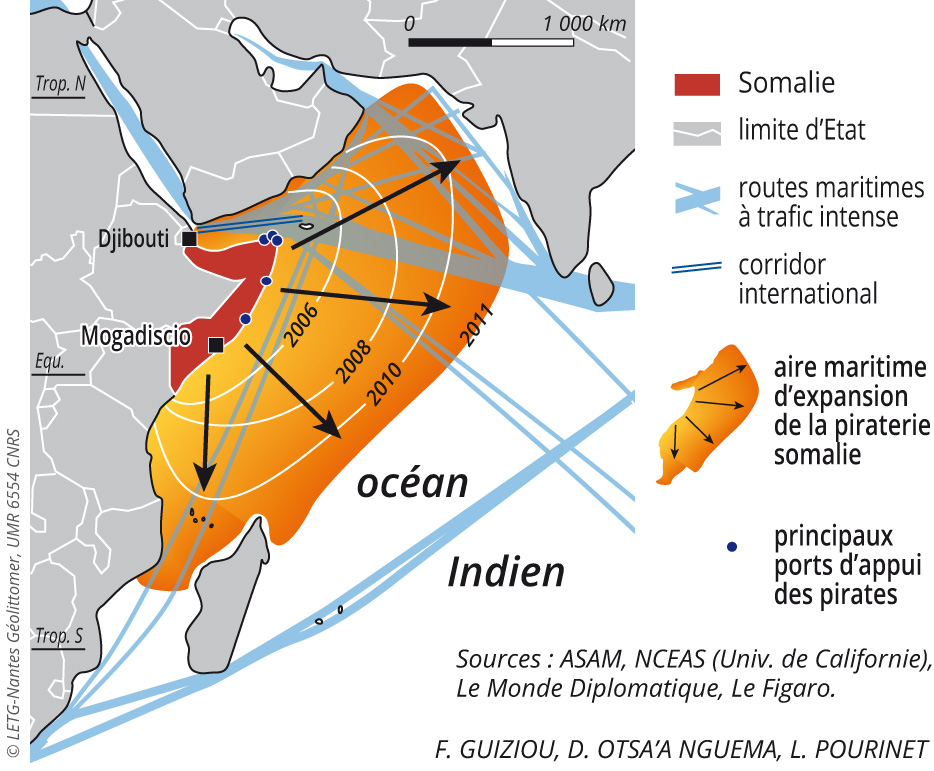Piracy worldwide and its recent developments (1985-2012). The case of Africa
By François GUIZIOU et Daenis OTSA’A NGUEMA
L’Atlas Bleu / Preventing
Maritime piracy, evolution, spatial characteristic, Gulf of Guinea, Gulf of Aden, Africa
Through maps and graphs, the article presents the world geographical context of maritime piracy and its recent evolution. Maritime piracy has been geographically refocused on the African “shores”. Then, it examines in details the piracy occurred on the coasts and seas of the African zones concerned by this phenomenon (Gulf of Guinea and Gulf of Aden), by comparing their main characteristics (targets, geographical scope).
Piracy in the world

Maritime piracy is a geographically widespread phenomenon affecting many coastal areas and seas around the world. It appears to pose a threat to maritime economies because of the numerous attacks aimed at the maritime transport industry, fishing vessels and yachts. Most acts of piracy – armed robbery, hijackings or kidnappings – occur near coasts. However, although these attacks are propagating along the coasts, they are also moving out onto the high seas and oceans in certain regions. The most striking aspect of this phenomenon today, at the beginning of the 21st century, is the fundamental developments and changes that have led to a shift in the concentration of piracy from Asia (Strait of Malacca) to African regions, like the Gulf of Guinea and, particularly, the Gulf of Aden.
The western Indian Ocean, the new center of gravity of piracy in the late 2010s

Definition
In addition to the somewhat insufficient definition given in Article 101 of the United Nations Convention on the Law of the Sea, the ICC International Maritime Bureau (IMB) defines an act of piracy as “An act of boarding (or attempted boarding) with the intent to commit theft or any other crime and with the intent or capability to use force in furtherance of that act.”. Often criticised for being too broad and vague, this definition is nonetheless the one most used in many reports and studies. The link often made between piracy and terrorism is somewhat fallacious, as the goals of these respective activities are quite different. Piracy criminally and occasionally disrupts maritime flows, whereas terrorism aims to block them to impact the economies that rely on them.
Piracy in Africa: spatial aspects specific to each coastline

West Africa: coastal piracy centered on Nigeria, linked to oil extraction

East Africa: piracy deployed on the high seas, linked to maritime routes

African piracy actually involves two different types of activity and method, as the way pirates operate differs from one African coast to the other. The eastern coast, giving onto the Gulf of Aden and the Indian Ocean, is characterised by acts of piracy on the high seas, committed by Somalis. Although the country does not have a seafaring tradition, these perpetrators have been quick to take on this new activity of kidnapping crews and hijacking ships. On the western coast, the Gulf of Guinea has seen a resurgence of piracy, with Nigeria as its epicentre. Although the motives remain vague – political and environmental demands – the pirates of the Gulf of Guinea target the oil industry and local port-based economies. Here also, as on the eastern coast, the pirates are lacking in maritime culture.
The geographical scope of the African piracy phenomenon also reveals two opposing trends. In the Gulf of Guinea, perpetrators only carry out attacks in coastal areas and piracy is contagiously spreading out along the coastline. In the Gulf of Aden, however, pirates only carry out attacks on major global maritime routes out on the high seas, sometimes travelling up to 2000 km away from the coast. However, this difference observed between the two African coasts should not make us forget that the piracy phenomenon can also be viewed as the modern-day use of a hitherto ignored spatial resource. Beyond the threat to humans and their activities, piracy can but serve to remind us that maritime space – out on the high seas at least – does not belong to anyone.





Leave A Comment